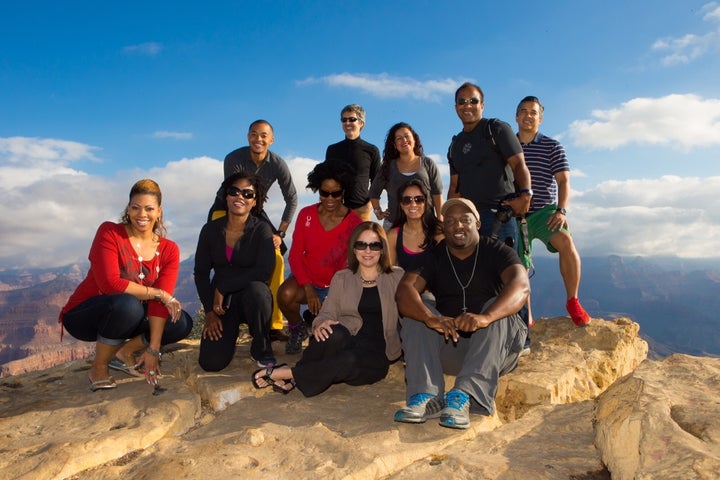
Members of the Diverse Environmental Leaders Speakers Bureau, advocates for the national parks, enjoying the Grand Canyon at “peak season.”
“We just discovered these places and now you want to take them from us?”
The plaintive cry from families in Liberty City came back to my ears with the announcement that the National Park Service plans to double fees at some of the most spectacular parks around the country. The people, mostly Black and from the lower economic spectrum, were speaking at a 1999 meeting on a proposal to convert nearby Homestead Air Force Base on the edge of Biscayne and Everglades National Parks, into an international airport.
Only weeks before, members of our Miami Community Partners group took the families on their first outing to Everglades National Park. They had fallen so massively in love with the beauty and peace and the sight of animals leisurely going about their lives, they were inconsolable at the thought of the havoc that flights taking off and landing nearby would wreak upon the parks.
People who had never before spoken at a public meeting stood up in front of US Air Force brass and made clear their passion for our parks. The proposal was soundly defeated, and today millions of people visit these parks each year and enjoy the amenities, never knowing what they owe to locals including the people of Liberty City.
US Rep. Frederica Wilson who defended the family of Sgt. La David Wilson represents Liberty City, and repeatedly asked us to take members of her 500 Role Models of Excellence to the Everglades. From the first trip, the young men came back with such tales of wonder that their peers were inspired to go.
This is the progression we have seen around the country – people are introduced to awe inspiring national parks and find that they are comfortable and safe, and they want to keep going back. Certainly that’s how it happened in our case beginning in 1995, and now I’ve visited 181 of 417 units of the park system.
The proposed rate hike from approximately $30 to $70 per car and doubling the walk in fees will affect 17 of our most iconic national parks, those considered the “Crown Jewels” of our country. The fees will be imposed at “peak season,” meaning their busiest time of year. So only those people who can afford the higher fees will be among the privileged to enjoy them at the time when the weather is best and most people have vacation time.
That means if you are in the Grand Canyon National Park, for example, you can look at the people around you and know that everyone has met a certain threshold of wealth. In nearby Tusayan, community members today are having to fight for the soul of the Grand Canyon against developers. 19 percent of the people of Tusayan live below the poverty rate, compared with 22.6 percent in Liberty City. A 100 percent increase in entrance fees is bound to affect one-fifth of the population that we need to bond to the parks to help protect them from encroaching development.
The Secretary of the Department of Interior which manages the Park Service says the fee increases will help pay for repairs of buildings and roads in the park. The cynicism of this statement can only be understood when placed in context of what else the Secretary champions – taking land OUT of the park system; reducing the Park Service’s budget from an inadequate $2.8 billion to $2.5 billion. The parks already have a huge financial backlog from being starved by the Republican Congress, presumably as a strategy to eventually declare them unsustainable and get them privatized. Simultaneously, the Secretary’s Strategic Plan ignores the prior administration’s successful efforts to engage Americans of color and young people, such as Find Your Park and Every Kid in a Park.
We should be making it EASIER for Americans to enjoy our parks, not harder, and the sooner we start, the better. (Our friends took their five year old son to the Grand Canyon in 2014 and to this day he keeps asking when they’re going back, and telling them it’s time to take his cousins there too.)
The most vital reason to keep the parks egalitarian is that their future completely depends upon the support of the American electorate, which is increasingly racially diverse. By adding their voices, the people of Liberty City helped keep Everglades and Biscayne National Parks alive. As more non-white representatives are elected to Congress, the chance of them voting to fund national parks when faced with pressing needs such as health care and education becomes increasingly slim.
Years ago I heard the president of a leading conservation organization opine that the future of our national parks depends on the extent to which growing non-white constituents embrace them. The people are eager to embrace the parks. Our “leaders” seem more ready to corrupt them.
������P*.=
